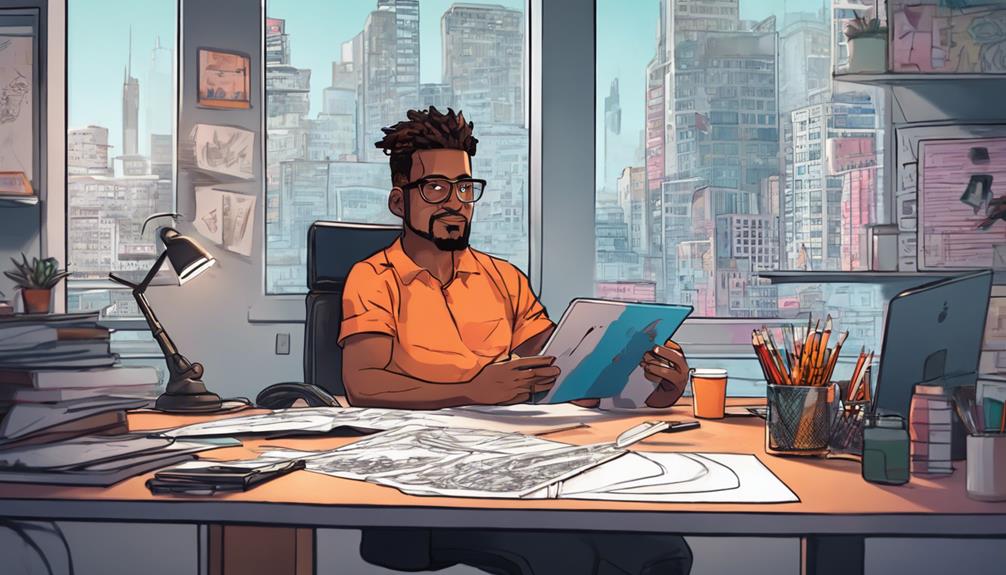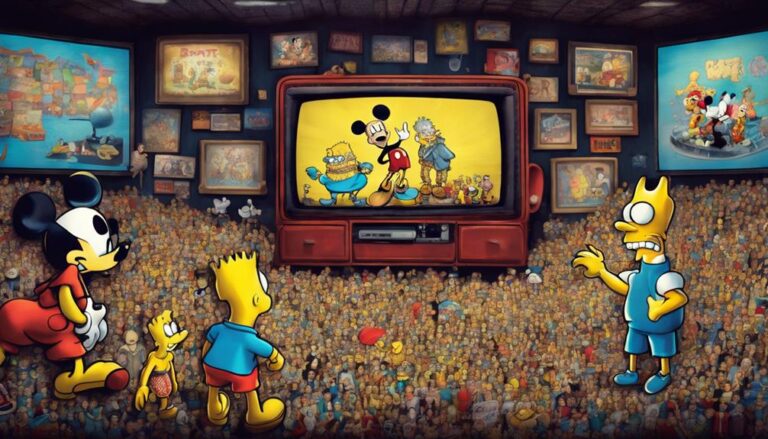Getting Hired as a Storyboard Artist in Animation
To land your dream job as a storyboard artist in animation, start by mastering the basics of drawing, understanding art fundamentals, and developing a distinct visual style. Practice sketching simple shapes and forms to refine your drawing techniques and study other artists' works for inspiration. Grasp fundamental principles of storytelling, including character arcs, emotional resonance, and a cohesive narrative flow. Build a strong portfolio that showcases your skills, versatility, and unique style, and don't be afraid to experiment and take risks. As you refine your craft, you'll unlock the secrets to bringing captivating stories to life.
Key Takeaways
- Develop a strong foundation in drawing and art fundamentals, including perspective, proportion, line art, and value.
- Master industry-standard software tools, such as Adobe Animate and Storyboard Pro, to bring your vision to life.
- Build a diverse portfolio showcasing your skills, versatility, and ability to tell compelling stories in animation.
- Network and make connections through industry events, online communities, and connections with other animation professionals.
- Prepare for job applications by researching studios, practicing common interview questions, and showcasing a distinct visual style.
Building Foundational Art Skills
Building Foundational Art Skills
To excel as a storyboard artist in animation, you'll need to develop a solid foundation in art skills.
This foundation is built on mastering the basics of drawing and understanding the fundamentals of art. Start by learning the principles of basic drawing, including perspective, proportion, line art, and value.
Practice sketching simple shapes and forms to develop your drawing skills.
Next, focus on refining your drawing techniques by studying the works of other artists and practicing different drawing styles.
Learn to render different textures, patterns, and details. Understand how to create depth and dimension in your drawings using layering, shading, and contrasting colors.
Mastering art fundamentals is crucial for creating engaging storyboards.
Study the basics of color theory, composition, and visual flow. Learn to balance elements in your drawings to create visually appealing compositions.
Practice drawing simple gestures and movements to capture the essence of characters and actions.
Understanding Storytelling Principles
Understanding Storytelling Principles
As a storyboard artist in animation, you're not just drawing images – you're weaving a visual narrative that captures the essence of a story. To do this effectively, you need to grasp the fundamental principles of storytelling. This involves creating a narrative that flows logically, with each scene building upon the last to form a cohesive whole.
A key aspect of storytelling is creating character arcs – the transformation a character undergoes throughout the story. This can be achieved by establishing a clear character goal, conflict, and resolution. Emotional resonance is also crucial, as it allows the audience to connect with the characters and become invested in the story.
Here's a breakdown of the key elements to consider when crafting a narrative:
| Element | Description | Example |
|---|---|---|
| Character Goal | What drives the character's actions? | A hero's desire to save their kingdom |
| Conflict | What obstacles must the character overcome? | A villain's attempt to destroy the kingdom |
| Emotional Resonance | How does the audience connect with the character? | The hero's bravery inspires the audience's admiration |
Creating a Strong Portfolio
As you build your portfolio, you'll want to curate a selection of projects that showcase your best work, highlighting your unique strengths and versatility as a storyboard artist.
When choosing key projects, consider the ones that demonstrate your mastery of visual storytelling and ability to convey emotion through your art.
Choosing Key Projects
Choosing key projects to showcase in your portfolio is crucial for grabbing the attention of animation studios and recruiters.
A strong portfolio should demonstrate your skills, versatility, and ability to tell compelling stories.
When selecting projects, consider the following factors:
- *Relevance to the job*: Choose projects that align with the specific job requirements and animation style.
- *Visual storytelling*: Select projects that showcase your ability to convey emotion, pacing, and narrative flow.
- *Technical skills*: Include projects that demonstrate your proficiency in storyboarding software and techniques.
- *Personal projects*: Consider adding personal projects that highlight your unique style and creativity.
- *Collaborations*: If you've worked with others, include projects that demonstrate your ability to take direction and work collaboratively.
When selecting projects, think about how they'll be perceived by potential employers.
Will they highlight your strengths and skills? Will they showcase your ability to work on a team and take direction?
Your project selection should complement your resume highlights, providing a comprehensive view of your skills and experience as a storyboard artist.
Developing Visual Style
Your project selection is in place, and now it's time to focus on developing a visual style that complements your skills and experience as a storyboard artist.
This involves creating a cohesive look that ties all your projects together.
Start by gathering visual references – images, films, or artwork that resonate with your style.
Collect these references in a dedicated folder or board to visualize your aesthetic.
As you curate your visual references, reflect on your artistic influences.
Are you drawn to the expressive lines of Disney's classic films or the stylized realism of modern anime?
Identify the elements that inspire you, and consider how you can incorporate them into your own work.
Your visual style should be a unique blend of these influences, tailored to your strengths as a storyboard artist.
When developing your visual style, remember that consistency is key.
Ensure that your color palette, line work, and composition are cohesive across all your projects.
By establishing a strong visual identity, you'll create a portfolio that showcases your unique voice and artistic vision.
This will help you stand out to potential employers and demonstrate your value as a skilled storyboard artist.
Learning Animation Software Tools
Mastering animation software tools is a storyboard artist's key to bringing their vision to life.
As you navigate the world of animation, you'll need to familiarize yourself with various software tools to stay competitive.
To get started, focus on building your skills in software navigation and tool efficiency.
- Learn the basics of each software tool, including shortcuts and hotkeys to streamline your workflow.
- Practice using different software tools to create a variety of storyboard styles and techniques.
- Experiment with different brush engines, such as those found in Toon Boom Harmony or TVPaint Animation.
- Familiarize yourself with industry-standard software tools, including Adobe Animate and Storyboard Pro.
- Watch tutorials and online courses to stay up-to-date on the latest software updates and features.
Developing Your Visual Style
You've mastered the animation software tools, and now it's time to focus on Developing Your Visual Style.
Finding your aesthetic is key, and it starts with exploring different styles, from classic cartoons to modern computer-generated imagery.
Finding Your Aesthetic
Developing a distinct visual style is key to standing out as a storyboard artist in animation.
Your aesthetic is a reflection of your artistic voice, showcasing your unique perspective and creative vision. It's what sets you apart from others and makes your work instantly recognizable.
To find your aesthetic, you'll need to explore and experiment with different visual elements.
- Color palette: What colors do you gravitate towards? Are you drawn to bright and bold, or muted and pastel?
- Line work: Do you prefer thick, expressive lines or thin, detailed ones?
- Texture and pattern: How do you incorporate texture and pattern into your work?
- Composition: How do you balance elements within a frame?
- Personal symbolism: What personal symbols or motifs do you incorporate into your work to add depth and meaning?
Refining Your Craft
Refining Your Craft
As you continue to explore and define your aesthetic, your focus shifts to refining the visual elements that make up your unique style.
This is where you distill your influences, experimenting with different techniques to create a distinctive visual language. Think of it as a process of editing, where you cut away unnecessary elements to reveal the essence of your style.
Effective time management is crucial during this phase.
Allocate specific times for creative experimentation, and set goals for what you want to achieve in each session. This could be as simple as exploring different line weights, testing the expressive potential of various brushstrokes, or pushing the boundaries of color and texture.
Through this process of refinement, you'll begin to see your style coalesce into a cohesive visual identity.
Your storyboards will become more confident, more expressive, and more uniquely yours. Remember, refinement is an ongoing process – one that requires patience, persistence, and a willingness to take risks.
Networking in the Industry
Attending industry events and joining professional organizations can significantly boost your career as a storyboard artist in animation.
These events provide a platform to meet fellow artists, learn about job opportunities, and get your work noticed by top studios.
You'll have the chance to attend industry conferences, film festivals, and exclusive studio tours, where you can network with professionals in the field.
Some ways to network in the industry include:
- *Attending industry events* like Comic-Con, Annecy International Animation Film Festival, and SIGGRAPH
- *Joining professional organizations* such as the Society of Children's Book Writers and Illustrators, the Animation Guild, and ASIFA-Hollywood
- *Participating in online communities* like animation forums, social media groups, and online portfolios
- *Visiting studios* and taking guided tours to learn about their workflow and meet artists
- *Volunteering* for events, festivals, and charity projects to meet industry professionals and build relationships
Preparing for Job Interviews
As you build connections and make your work visible in the industry, you're likely to start receiving job interview invitations from top studios. It's essential to prepare thoroughly for these interviews to showcase your skills and increase your chances of landing a job as a storyboard artist in animation.
Interview Prep Checklist
| Category | Action Items |
|---|---|
| Research | Learn about the studio's current projects, their style, and their team. Review their website, social media, and recent releases. |
| Common Questions | Prepare answers to common interview questions, such as "What's your experience with storyboarding software?" or "How do you handle feedback and revisions?" |
| Portfolio Review | Review your portfolio to ensure it's up-to-date and showcases your best work. Be prepared to walk the interviewer through your process and inspirations. |
During the interview, be ready to discuss your experience, skills, and passion for storytelling. Practice answering common questions and be prepared to ask thoughtful questions about the studio and the role. By being prepared, you'll demonstrate your enthusiasm and professionalism, making a positive impression on the interviewer.
Landing Your First Job
Securing your first job as a storyboard artist in animation can be a thrilling milestone, and it often requires a combination of preparation, persistence, and a bit of luck.
Now that you've honed your skills and prepared for interviews, it's time to focus on landing that first job.
Effective job search strategies can make all the difference in this competitive field.
To boost your chances of success, consider the following:
- Build a strong online presence: Create a professional website showcasing your best work, and optimize it for search engines to improve visibility.
- Network and make connections: Attend industry events, join online communities, and connect with other animation professionals to learn about job opportunities and get tips from experienced artists.
- Customize your application materials: Tailor your resume and cover letter to each job you apply for, highlighting the skills and experience that match the job requirements.
- Practice your pitch: Develop a clear and concise verbal pitch that showcases your skills, experience, and passion for storyboarding.
- Follow up: After applying, be sure to follow up with the studio or employer to express your interest in the position and inquire about the status of your application.
Frequently Asked Questions
Can I Work as a Storyboard Artist Without Drawing Skills?
You can still convey an artistic vision through visual storytelling without drawing skills, using written descriptions or visual aids, but as a storyboard artist, your role heavily relies on drawing to effectively communicate ideas.
How Long Does It Take to Become a Storyboard Artist?
You'll spend years honing your skills, as it takes time to develop your craft. Skill development is key, and you'll build a strong portfolio through consistent practice, dedication, and refining your visual storytelling abilities sequentially.
Do I Need a Degree to Work in Animation?
You don't necessarily need a degree to work in animation. Many self-taught artists thrive, and online courses can fill skill gaps, allowing you to build a portfolio and showcase your talent to potential employers.
Can I Specialize in a Specific Type of Animation?
You can specialize in anime styles like vibrant action sequences or gaming genres like immersive RPGs. Your unique style blends bold lines, bright colors, and dynamic poses, making your art instantly recognizable in the industry.
Is Remote Work Common for Storyboard Artists?
You're likely to find remote work options in various industries, especially in virtual studios and freelance opportunities, where digital collaboration is key, offering flexible work arrangements that don't require a traditional office setup.
Conclusion
You've honed your art skills, grasped storytelling principles, and crafted a portfolio that shines. Your animation software skills are sharp, your visual style unique, and your industry connections strong. With a confident attitude and thorough interview prep, you're ready to land your first job as a storyboard artist. Imagine yourself in a bustling animation studio, bringing characters to life and stories to the screen – your dream career is within reach.







